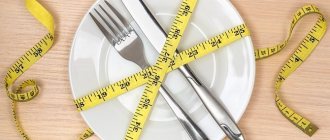Many of us have heard or read about the benefits of fasting. Famous people, including recognized yoga teachers and competent nutritionists, spoke and wrote about the need to give up food.
Medical fasting came to our country relatively recently; In one form or another, fasting was talked about during the Soviet era, but the official position of medicine and the authorities was unequivocal: vegetarianism, like fasting, was recognized as the “corruptive influence of the West,” and the softest thing that awaited the supporters of such theories were sidelong glances colleagues and relatives.
In the mid-80s, Porfiry Ivanov called on supporters of his system to give up food once a week for a day in order to cleanse the body, but most people were hostile to these ideas as a hardening technique. The situation changed dramatically in the early 90s, when many people discovered different diets and nutrition systems; Among them, the works on food compatibility by Herbert Shelton were popular, who, among other things, assured his supporters of the benefits of therapeutic fasting.
Despite the abundance of information, many gaps remain in the issues of fasting and the correct way out of it. If you are well versed in this topic, then it is unlikely that you will learn much new from this article, but it will not hurt to brush up on your knowledge. If you are just planning to start fasting, then it will be important to once again remember its benefits for maintaining motivation, and also understand how to properly exit it so as not to harm your body.
Benefits of fasting
When it comes to fasting, motivation plays an important role. A person needs to understand what he is doing and why. Therefore, before we talk about how to start fasting and complete it correctly, we will emphasize the benefits that the body can receive from this process.
- Development of discipline. During fasting, you learn to control your feelings and manage your desires. This is certainly an important quality that will help you in various situations, such as when switching to a healthy, balanced diet. Following any diet will be much easier if you have experience of fasting.
- Losing weight. This is perhaps the most obvious benefit of fasting. When we refuse to eat, our body starts the fat burning process. During a fast, you will burn fat mass without losing muscle mass, which is especially important for athletes.
- Prevention of diseases. Fasting is the prevention of diseases, including non-infectious gastritis, problems with the liver and gastrointestinal tract, pancreatitis.
- Strengthening the immune system. You will become less susceptible to infectious diseases, chronic fatigue, a common cause of which is a sludge buildup in the body, will disappear.
- Cleaning from slags. Over the years, the body becomes clogged, slagging leads to malfunctions of the internal organs, but the combination of fasting and vegetarianism allows you to cleanse the body faster.
Mahatma Gandhi said that fasting is necessary because it opens one's view of the spiritual world. In various religious teachings we can find information that individuals who realized themselves in the spiritual field voluntarily gave up food.
Buddha Gautama did not eat for 40 days - after this period the path to liberation was open to him. Supporters of Jainism are well aware that Mahavira adhered to a certain diet, where the emphasis is on complete abstinence from food. For spiritual transformation, religious doctrines advise their adherents to periodically abstain from food.
It becomes obvious that fasting is not only a way to restore lost health or figure, but also a method of spiritual transformation.
What is therapeutic fasting
Let us repeat, therapeutic fasting is a voluntary refusal of food in order to improve the health of the body and get rid of the hated kilograms. The so-called velvet fasting according to Ziganshin is very popular among supporters of extreme methods. Another system that became famous was proposed by Paul Bragg. The system includes recommendations for observing fasts and lists of foods that should be abandoned forever. In previous articles, we talked to you about fasting, the author of which is E. Osumi. According to his theory, it was divided into schemes: 16/8, 12/12, 14/10, 20/4, 36, 5/2 hours. But today we are talking about other two types: water and dry.
On the water
Water fasting involves abstaining from food. Drinking the daily amount of water is a prerequisite for this type of diet. Due to the deprivation of the natural function of digesting solid food, the digestive tract begins to cleanse itself. First, feces are removed, then waste and toxins. The intestinal microflora is normalized, since pathogenic organisms are not able to exist in conditions of lack of nutrition.
Long or cyclical courses without food trigger autophagy processes. The cells begin to cleanse themselves. In this case, harmful components are removed, thus explaining recovery from certain diseases. Some adhere to a soda and water fast. The water system of morning fasting by Ishihara Yumi is very popular.
You can lose up to 1 kilogram per day on this diet. But such large numbers for one day are frightening and raise doubts about the ability to maintain the result after leaving the diet.
Dry medicinal
Dry fasting involves complete abstinence from food and water. Fortunately, even the most outspoken fighters against waste and toxins do not advocate using this method for more than two days. It is possible to live without food for some time, but without water, you are more likely to develop dehydration. Water is the force that gives organisms life. We must not forget this simple rule.
Varieties:
- Complete dry fasting - author L.A. Shchennikov. Lasts 7, 9, 11 days.
- Cascade - author V.P. Lavrova.
- Fractional (intermittent) - author S.I. Filonova.
What are the contraindications to fasting?
Contraindications to fasting are divided into two groups: absolute and relative. The difference is that if you have relative contraindications, then you can start fasting after consultation with a specialist (doctor, nutritionist).
Absolute contraindications put a complete ban on this practice. To avoid harm, always remember that dubious nutrition gurus from the Internet are not the ultimate truth; sometimes they may not only have no medical education, but no education at all. Promising to cure any disease, they are capable of driving their supporters to death.
Therefore, even if you do not have the contraindications described below, consult with a specialized specialist before starting fasting, since some diseases can occur in a latent form (for example, heart disease).
Absolute contraindications include:
- malignant blood diseases;
- psychoneurological diseases;
- oncology;
- diabetes;
- heart attack, heart disease;
- ulcer, cirrhosis of the liver;
- purulent processes in internal organs, including the respiratory organs.
Relative contraindications to fasting:
- food poisoning;
- diabetes mellitus type II;
- gout;
- urolithiasis disease;
- hypertension;
- venous insufficiency.
Before we talk about the features of breaking fasting depending on its duration, we note several general recommendations and rules that should be followed during fasting.
The essence of fasting
The essence of fasting is complete abstinence from food or abstinence from certain foods. At the same time, a person consumes clean water. An exception is the so-called dry fasting , in which drinking is not provided. But this technique is quite unsafe for health, so it should not be practiced for a long time without medical supervision under any circumstances.
Regular, “wet” fasting is practiced for varying amounts of time. At the same time, a person must consume water, which is vital for all processes in the body, in particular for its active cleansing of harmful substances. The most suitable in this case is distilled water.
It is very important that a person has a correct idea of what is ahead of him. If you fast without clear goals for success, breakdowns and the wrong approach to this process are inevitable. Therefore, it is important not only to follow all the rules, but also to psychologically prepare yourself for refusing food.
Hunger is important not only for cleansing the body, but also for restructuring metabolic processes. The essence of hunger is a certain reboot of the body, which allows a person to subsequently feel much better.
But if we outline other goals of fasting, it is important to note that people decide to use this technique not only for general health, but also for spiritual improvement.
Therapeutic fasting: how to enter and exit correctly
During the fasting process, entering and exiting the practice is equally important. The most common mistake is when a person simply refuses to eat for a day, and then consumes various dishes with a vengeance. This is not fasting, but torture for the body. General recommendations for entry may be as follows:
- Motivation. Understand why and why you are doing this, make a decision and do not deviate from your intended goal.
- Change your diet. Give up fast food and soda, eat light meals. A week before starting your fast, give up meat and fish. Eggs should also be excluded a week before the start of practice.
- If you smoke, reduce the number of cigarettes. You cannot smoke on a fasting day.
- Set aside a day to fast when you can stay at home. Daytime naps will be helpful.
- Drink more water.
- Start fasting in the evening by skipping dinner.
General recommendations for breaking fasting.
- The duration of the exit is equal to the days of fasting. If you fasted for a week, then the exit from the practice will also be seven days. This must be taken into account when choosing a fasting regimen.
- When going out, eat small meals.
- Increase the amount of food gradually. It is better to add one or two products every day.
- After fasting, you should not eat salt and seasonings, as well as fatty and protein foods.
- After fasting, you should not drink tea or coffee.
- The first product for you, regardless of the duration of fasting, should be juice. First, drink juice diluted with water, then gradually switch to regular juice. The juice should be drunk in small quantities every 2 hours.
- Then include fermented foods in your diet.
Therapeutic fasting at home
At home, it is recommended to try a trial refusal to eat for 34 hours, no more than once a week, on certain days. A systematic approach will help increase the number of days to three or more.
Daily allowance
Avoiding food for one day is the safest option. A daily diet will allow the organs of the digestive system to rest and allow the microflora to recover.
Recommendations:
- Go on a fast on the weekend, giving up heavy food in advance. Try to drink more.
- Take a bath, shower. Walk more.
- Periodic practice will help get rid of headaches and dizziness.
- At the end of the program, it is recommended to prepare salads from carrots, cabbage, apples and raisins. You can season it with lemon juice.
- Keep for no longer than 24-36 hours
Three-day
The stress from the three-day course is already greater than from the previous option. It is better to start it after a one-day fast.
Recommendations:
- Give up heavy meals for a week. For three days, eat plant foods, and on the day you start the diet, do a cleansing enema.
- Take frequent baths and showers. Drink more clean water.
- Listen to your own well-being. If it’s difficult to complete the course, give up the idea.
- You need to exit the diet gradually, without overeating.
Seven days
Week-long fasting has therapeutic purposes. During this time, self-destruction of diseased unnecessary components of cells and tissues occurs, and the regeneration process begins.
Recommendations:
The preparatory stage should take at least two weeks. During this period, animal products, alcohol and sweets are excluded. In addition to cleansing the intestines, cleansing the liver is required. You can take a course of special medications.
How to break a one-day fast
A one-day fast involves following an eating pattern known as intermittent fasting. The system of intermittent fasting with such a short period of abstinence from food does not provide specific recommendations for exit, so let’s turn to other sources. Paul Bragg and Herbert Shelton recommend giving up food for a day once a week. We remember the main rule: the entrance and exit from fasting are equal in duration.
It is best to start with juice, let it become a light breakfast for you. After 5–6 hours, the body will return to its previous rhythm, then you should have lunch with cabbage and carrot salad. Alternatively, you can eat steamed vegetables or applesauce. Protein foods can be left for the evening.
From the next day, you can eat your usual dishes, but do not rush into food, eat half of your usual portion, and chew your food thoroughly. The way out of a one-day fast is the simplest.
If you have chosen a dry fasting scheme, then you need to start by drinking water in small quantities, then replace the water with juice. On the second day, you can eat a light salad or fruit puree. Dishes that have undergone heat treatment can only be eaten on the third day. Similar to a one-day fast, you need to start with half the usual portion.
Benefits and harm to the body
Let's talk about the benefits of fasting:
- Respite for the gastrointestinal tract. Due to the abundance of food, a person often does not control his appetite. Overeating often occurs, so rest for the digestive system is also necessary.
- Metabolic restructuring. During a hunger strike, the body uses up its own internal energy reserves. Fat reserves begin to decrease, which leads to weight loss.
- Longevity. The rejuvenation effect is achieved through the effects of hunger at the cellular and molecular levels.
- Cure various diseases, the list of which we provided above.
It turns out that the technique is useful for weight loss, rejuvenation and healing. But, do not forget about the other side of the coin.
Flaws:
- The risk of muscle loss increases. During a hunger strike, the body does not immediately begin to break down fats. Glucose and proteins are the first to be shot. Long-term refusal of food leads to muscular dystrophy.
- Poisoning with ketone bodies - fat breakdown products. With a lack of food, the level of glucose in the blood decreases - a lack of insulin develops. Fats cannot undergo complete oxidation under such conditions. This is how acidosis occurs, the main symptom of which is the smell of acetone from the oral cavity. In this case, we can talk about increasing intoxication.
- Appetite disorders. Long-term refusal of food results in the appearance of an uncontrollable feeling of hunger. It becomes difficult for a person to control his appetite, and regular overeating begins.
- Modern doctors argue about the accumulation of toxins. They claim that the lymphatic, urinary and circulatory systems cope with their own functions without any additional techniques.
How to break a water fast correctly
It is logical to ask: what is the correct way to end a water fast? The scheme is no different from dry fasting, it’s just that the way out will start not with water, but with juice. Vegetable juices are best.
After a person has already become accustomed to a 36-hour fast, if desired, you can move on to the next step and refuse food for seven days. Of course, it is harder both mentally and physically. Motivation is important here: do not despair if a breakdown occurs, think about the reasons that led to this, and take them into account the next time you try to fast.
There are several schemes for breaking a 7-day fast, we will consider each in detail.
How to break a 7-day fast
- Emergency exit (1–2 days). This solution can be classified as drastic measures; it can be resorted to only under the supervision of a doctor. On the first day you eat cabbage and carrot salad, you can add an apple. You cannot dress the salad. For dinner you can eat stewed vegetables. From the second day, you can add a few drops of olive oil to the salad. Salt and spices are prohibited. You can drink juices diluted with water. This option is acceptable for those who do not have health problems.
- Out in 4 days. The diet will be the same, but from the third day you can add fermented milk products. It is better to avoid meat and legumes. With this option, you can begin to perform simple physical exercises.
- Recommended (7 days). As you already remember, the exit from fasting is equal to the period of abstinence from food, so this option will be optimal. The first day you can drink juices diluted with water, keep the ratio 1:1. You should not drink more than 2 liters of juice per day. The second day you also need to drink only juice, but not diluted. On the third day, the body is ready to work as before, but you should not overload it. Eat vegetables and fruits, you can eat light porridge. On the fourth day you can eat vegetable soups and purees. On the fifth day, you can introduce a small amount of fermented foods into your diet. From the sixth day, you can add salt to your food, and you can also introduce porridge into your diet: oatmeal or buckwheat would be a good option. From the seventh day, you can start eating as before, but remember an important rule: the portion should be half the usual size.










